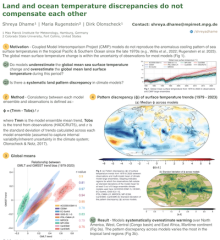Land and ocean temperature discrepancies do not compensate each other
Shreya
Dhame
Max Planck Institute for Meteorology
Poster
The global mean surface temperature (GMST) has risen significantly over the years. Since 1880, the Earth's temperature has increased by an average of 0.08° Celsius per decade, totaling about 1.1°C by 2022 (IPCC, 2023). Turning to regional temperature trends, Coupled Model Intercomparison Project (CMIP) models do not reproduce the anomalous cooling pattern of sea surface temperatures (SSTs) in the tropical Pacific and Southern Ocean since the late 1970s (Willis et al., 2022; Rugenstein et al. 2023). Here,
we first check if the systematic anomalous cooling pattern contributes to an overestimation of global mean sea surface temperature change in nine climate model large ensembles during this period. Models did not overestimate global mean sea surface temperature change in the ensemble means. Following this, we checked if models can reproduce the global mean and patterns of land temperature trends more consistently. Our hypothesis was that there is a systematic land pattern discrepancy in models to compensate for their SST pattern discrepancy, resulting in a simulated global mean surface temperature change that is within the uncertainty of the observations. Results indicate that while land surface temperature trends in models show some systematic pattern discrepancies from observations, they do not consistently compensate for the ocean discrepancies in driving GMST trends. Models have different regionally compensating errors in surface temperature trends over land and oceanic regions. An open-ended question is what causes the land surface temperature pattern discrepancy in models?
we first check if the systematic anomalous cooling pattern contributes to an overestimation of global mean sea surface temperature change in nine climate model large ensembles during this period. Models did not overestimate global mean sea surface temperature change in the ensemble means. Following this, we checked if models can reproduce the global mean and patterns of land temperature trends more consistently. Our hypothesis was that there is a systematic land pattern discrepancy in models to compensate for their SST pattern discrepancy, resulting in a simulated global mean surface temperature change that is within the uncertainty of the observations. Results indicate that while land surface temperature trends in models show some systematic pattern discrepancies from observations, they do not consistently compensate for the ocean discrepancies in driving GMST trends. Models have different regionally compensating errors in surface temperature trends over land and oceanic regions. An open-ended question is what causes the land surface temperature pattern discrepancy in models?

Poster file
dhame-shreya-confronting-poster.pdf
(2.56 MB)
